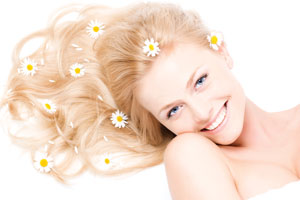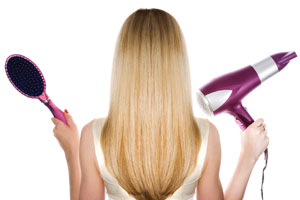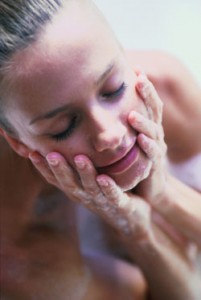Summer Hair Care

Summer Hair Care
Strong sunlight and salt-laden wind are hard on your tresses, but there
are natural ways to restore bounce and shine.
By Susan Weiner, Energy Times
It’s summertime and the living may be easy. Summer elements, however, are anything but easy on your hair, which is exposed to salt water or chlorine (or both), dry winds and high humidity. The damage these elements can cause often results in locks that are drab, dry or frizzy.
When confronted by such environmental exposures, “lather, rinse and repeat” just isn’t enough to keep your hair in tip-top shape on long hot days. To achieve that magnificent mane, it may be time to step away from your traditional routine and evaluate new approaches to hair care.
Each of us has approximately 100,000 scalp hairs that grow from one-quarter to one-half inch every month from structures called follicles. Each hair shaft has three layers; the cuticle, or outside layer, protects the inner two. When the scales that make up the cuticle lie flat and reflect light, hair is shiny and healthy. When the hair shaft is damaged these scales separate and hair becomes dry, dull and prone to breakage.
Whether hair is straight or curly also influences shine. Sebum, a protective oil produced within the follicles, spreads out and covers straight hair easier than curly or wavy hair. This is why straight hair often appears shinier than a head full of curls.
The longer the hair, the longer it has been exposed to harsh elements such as scorching sun and chlorinated pool water during the summer (as well as cold outdoor air and overheated indoor air during the winter). Over time, these conditions take their toll, zapping your hair’s luster and sheen.
Ayurvedic Benefits
 A 5,000-year-old system of holistic healing from India, Ayurveda steers away from chemical-based hair care and emphasizes all-natural treatments that combine wholesome foods, herbs, scalp massage, aromatherapy and yoga. Individual mind-body types, or doshas, determine the specific combination of each individual. Someone with a vata constitution, for example, may have naturally frizzy or coarse hair and struggle with dandruff and split ends. A pitta person may have light-colored, fine hair that may go gray or thin out early, while a kapha individual is likely to have full, abundant hair that is less prone to damage. (To determine your dosha, go to www.whatsyourdosha.com or find a trained practitioner through the National Ayurvedic Medical Association at www.ayurveda-nama.org.)
A 5,000-year-old system of holistic healing from India, Ayurveda steers away from chemical-based hair care and emphasizes all-natural treatments that combine wholesome foods, herbs, scalp massage, aromatherapy and yoga. Individual mind-body types, or doshas, determine the specific combination of each individual. Someone with a vata constitution, for example, may have naturally frizzy or coarse hair and struggle with dandruff and split ends. A pitta person may have light-colored, fine hair that may go gray or thin out early, while a kapha individual is likely to have full, abundant hair that is less prone to damage. (To determine your dosha, go to www.whatsyourdosha.com or find a trained practitioner through the National Ayurvedic Medical Association at www.ayurveda-nama.org.)
Ayurvedic practices are ideal for sun-stressed hair. “Typical Ayurvedic treatment will include massage of the scalp with medicated oils, which have extraordinary qualities,” says Suteja Navarro, CAS, PKS, founder of OmSpring in San Francisco, California. “Ayurvedic knowledge teaches that there is a true digestive system that operates through the skin, including the scalp. This is why Ayurveda recommends putting nothing on the skin that we cannot eat.”
Oils such as almond, coconut, olive or sesame soften hair and protect it from the elements, lubricate and replenish the scalp and enhance blood circulation to the head and neck. Oils should be warmed before use and applied little by little using the pads of the fingers, massaging gently in a circular motion. For flaky summer scalps, a mixture of olive oil, cinnamon and honey can be applied. Amla oil, one of the world’s oldest natural conditioners, is said by Ayurvedic practitioners to rejuvenate hair growth.
Aromatherapy offers other hair-friendly oils in the form of plant essences. In one study, massaging in a blend of lavender, rosemary, thyme and cedarwood oils improved hair growth among people with thinning hair (Archives of Dermatology 11/98). Lavender oil also helps repair split ends and ease scalp dryness, as do oils taken from rosewood, sandalwood, yarrow, lemon balm, bay and cypress. “Ayurveda includes aromatherapy as a healing modality,” says Navarro. “You may add these essential oils to your homemade shampoo or directly massage your scalp with an essential oil adapted to your case.”
 Ayurvedic herbs such as neem, turmeric and amla powder can be mixed with warm water and applied to weather-damaged hair as a rejuvenating paste, while neutral or colorless henna powder mixed with water strengthens the hair shaft. (Pigmented forms of henna let you color your hair naturally.) A final rinse with apple cider vinegar or sage tea can help stimulate hair growth.
Ayurvedic herbs such as neem, turmeric and amla powder can be mixed with warm water and applied to weather-damaged hair as a rejuvenating paste, while neutral or colorless henna powder mixed with water strengthens the hair shaft. (Pigmented forms of henna let you color your hair naturally.) A final rinse with apple cider vinegar or sage tea can help stimulate hair growth.
Scalp Stimulation
Scalp massage is far more than simply a relaxing form of stress relief. It stimulates circulation, nourishes the follicles and distributes natural oils, sending nutrients to damaged hair and creating an ideal environment for healthy new hair growth.
“Massage brings blood flow, sloughs off the dead skin cells and gives bounce to the hair,” explains Tod Peterson, CMT, of Advanced Massage in Pleasant Hill, California. “I massage the full scalp in different directions. It’s a vigorous finger massage to slough the scalp and rejuvenate the hair follicles so that the hair can grow faster.” Doing self-massage on a regular basis can help maintain the health of your hair (if your scalp is oily you may require fewer massages).
There are two basic types of scalp massage. Use the balls of the fingers in rapid movements over the scalp during the friction massage, moving the fingers in circular movements starting from the front of the head toward the nape of the neck, then use the same motions to move forward to the front of the head. To perform a kneading massage, spread the balls of the fingers over the scalp, press firmly and rotate the skin, but do not move fingers over the scalp. Slowly rotate the skin in one area, and then move to another area until the massage is complete.
In addition to maintaining a basic haircare routine, preventative steps need to be taken in the summertime to ensure that your hair does not become damaged. Do not brush or blow-dry excessively, shampoo hair soon after swimming and avoid over-exposure to wind and sun.
Nutrition for Healthy Tresses
You may be having a bad hair day because of what you put in your mouth. “Deficiencies in essential fatty acids, the vitamin B complex, protein, zinc, iodine and other trace minerals may cause less-than-healthy hair,” says Tara Lambert, BA, CNC, EFT-CC, of Nutritional Wellness Center in Ithaca, New York. “These types of nutritional deficiencies may cause dry, brittle, weak hair that lacks shine and luster. They may also cause the hair to grow very slowly or be very fine and thin.”
Eating certain foods on a regular basis can support hair health. Salmon is loaded with protein along with omega-3 fatty acids and vitamin B-12. Dark green vegetables provide vitamins A and C to produce sebum, while beans offer zinc and biotin as well as protein. A handful of selenium-rich nuts and seeds each day can help safeguard your scalp. Additional hair helpers, including iron to help the blood transport oxygen to follicles, vitamin B-6 for color and strength and calcium for growth, can be found in fruits and vegetables, lean meats, eggs, brewer’s yeast, low-fat dairy products and whole grains.
Pay close attention to your diet during warmer weather when hair may be prone to additional nutritional deficiencies. “Sweating could cause a person to lose trace minerals if they don’t replenish them through healthy foods and drinks,” says Lambert. “Swimming in chlorinated pools may also deplete the body of iodine, which is needed for fast-growing, thick hair.” What’s more, year-round sources of hair stress such as toxins, cigarette smoke, alcohol consumption and lack of sleep can result in dull, lifeless hair or even retarded hair growth. And don’t forget the effects of age, which reduces the number of capillaries supplying nutrient-rich blood to the follicles.
For all these reasons a daily intake of essential vitamins and minerals can help keep your hair at its healthy best. Vitamin E, for example, encourages blood circulation to the scalp by increasing the uptake of oxygen, while vitamins B-12 and C, along with the amino acid lysine, aid in the absorption of iron and other nutrients. Beta-carotene, which the body converts to vitamin A, promotes healthy hair, skin and nails. Certain minerals, such as magnesium, zinc, silica and sulfur (available in supplement form as MSM) are also crucial for hair health. The herb saw palmetto is thought to help reverse hair loss because it lowers levels of DHT, a type of testosterone that harms follicles. According to a study in the April 2002 Journal of Complementary Medicine, saw palmetto actually triggered hair growth.
“To support healthy hair, look for supplements that contain the vitamin B complex, including biotin, vitamin C complex, vitamin E complex, zinc, trace minerals, iodine and essential fatty acids containing omegas-3, 6 and 9,” says Lambert, who prefers supplements made from whole foods.
“Fish, flax, primrose and black currant seed oils are all good essential fatty acids.” Some supplements provide omega-3, -6 and -9 essential fats in carefully balanced formulations.
From nutritional changes to scalp massage to essential oil use, a full, beautiful head of hair is the natural outgrowth of a health-conscious lifestyle. It’s never too late to possess flowing tresses that are kissed by the sun and tousled by the wind—without being mangled by either.

